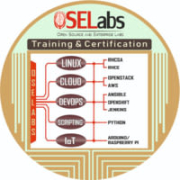Red Hat Ansible Automation Platform is a powerful network automation solution that allows organizations to handle every aspect of their application launch process within a single product. It enables users to share their automations so that teams within an organization can collaborate on various projects with ease. Ansible Automation Platform is designed to be used by all employees involved in the network automation process.

| Product | Market Share (%) |
|---|---|
| Red Hat Ansible Automation Platform | 16.6% |
| Microsoft Configuration Manager | 11.8% |
| AWS Systems Manager | 10.4% |
| Other | 61.199999999999996% |
| Type | Title | Date | |
|---|---|---|---|
| Category | Configuration Management | Aug 29, 2025 | Download |
| Product | Reviews, tips, and advice from real users | Aug 29, 2025 | Download |
| Comparison | Red Hat Ansible Automation Platform vs Microsoft Intune | Aug 29, 2025 | Download |
| Comparison | Red Hat Ansible Automation Platform vs Microsoft Configuration Manager | Aug 29, 2025 | Download |
| Comparison | Red Hat Ansible Automation Platform vs Red Hat Satellite | Aug 29, 2025 | Download |
| Title | Rating | Mindshare | Recommending | |
|---|---|---|---|---|
| Microsoft Intune | 4.1 | 9.9% | 94% | 298 interviewsAdd to research |
| GitLab | 4.2 | N/A | 97% | 85 interviewsAdd to research |
| Company Size | Count |
|---|---|
| Small Business | 19 |
| Midsize Enterprise | 5 |
| Large Enterprise | 37 |
| Company Size | Count |
|---|---|
| Small Business | 415 |
| Midsize Enterprise | 275 |
| Large Enterprise | 1464 |
Red Hat Ansible Automation Platform Benefits
Some of the ways that organizations can benefit by choosing to deploy Red Hat Ansible Automation Platform include:
Red Hat Ansible Automation Platform Features
Reviews from Real Users
Red Hat Ansible Automation Platform is a highly effective solution that stands out when compared to many of its competitors. Two major advantages it offers are its automation manager and its comprehensive centralized GUI-based management interface.
MD J., a solution architect at STBL, says, “The automation manager is very good and makes things easier for customers with multi-cloud platforms.”
Aankit G., a Consultant at Pi DATACENTERS, writes, “We like the GUI-based interface for the tower. Before, we only had a command-line interface to run all the Ansible tasks. Now, the Ansible tower provides the complete GUI functionality to run, manage, and create the templates and the Ansible jobs. This includes the code and YAML file we can create. The GUI interface is the added advantage of this solution, including some integration with the different plugins.”
Red Hat Ansible Automation Platform was previously known as Ansible.
HootSuite Media, Inc., Cloud Physics, Narrative, BinckBank
| Author info | Rating | Review Summary |
|---|---|---|
| Cognitive Business Operation at a consultancy with 10,001+ employees | 3.5 | I've used Red Hat Ansible Automation Platform since 2018 for infrastructure and cloud automation. It's stable and easy to integrate but expensive, and lacks strong dashboarding. Support needs improvement, and Terraform is preferred by many AWS users. |
| IT Engineer at a financial services firm with 1,001-5,000 employees | 3.5 | I use Red Hat Ansible Automation Platform for system administration tasks, appreciating its simplicity due to the YAML language for developing playbooks and roles. However, the platform needs more detailed dashboards, as the current ones are lacking. |
| Systems Anslyst VII - Infrastrusture at a government with 10,001+ employees | 4.5 | We use Ansible primarily to update OpenShift and manage over 800 servers, appreciating its ease and efficiency. Despite the need for better Windows support, it saves us 30-40% in time, outperforming rivals like Chef and SAS. |
| IT Specialist at Los Angeles County Internal Services Department | 5.0 | I manage the open system section in a county, utilizing Red Hat Ansible Automation Platform to streamline security software installation and virtual machine deployment. It's user-friendly but I wish it were more consumer-oriented. Ansible's cost is higher than using bash scripts. |
| Associate Software Test Solution Architect at AFour Technologies | 4.0 | I primarily use Ansible for deployment automation and CI/CD pipelines. Its automation capabilities enhance reliability, though it needs more support for microservices and Kubernetes. Compared to Terraform, Ansible lags in microservice deployments but improves scripting and maintainability. |
| System Administrator at a university with 10,001+ employees | 5.0 | We use Red Hat Ansible Automation Platform for system compliance and infrastructure management due to its scalability and ease of use compared to Puppet. Despite integration issues, its flexibility and lightweight structure make it cost-effective and suitable for our needs. |
| Software Architect at RedesCDM | 4.0 | We utilize Red Hat Ansible Automation Platform to automate servers and applications, appreciating its strength in final configurations over Terraform. Although Ansible's server-centric approach limits cloud integration, it's superior to BladeLogic, offering more functionality and user familiarity. |
| Software Architect at OSELabs | 4.5 | We primarily use Ansible for automation, managing DNS, web servers, and virtual hosts. It offers valuable flexibility in handling deployments and configurations. However, the graphical interface and installation can be challenging, especially in open-source versions. |